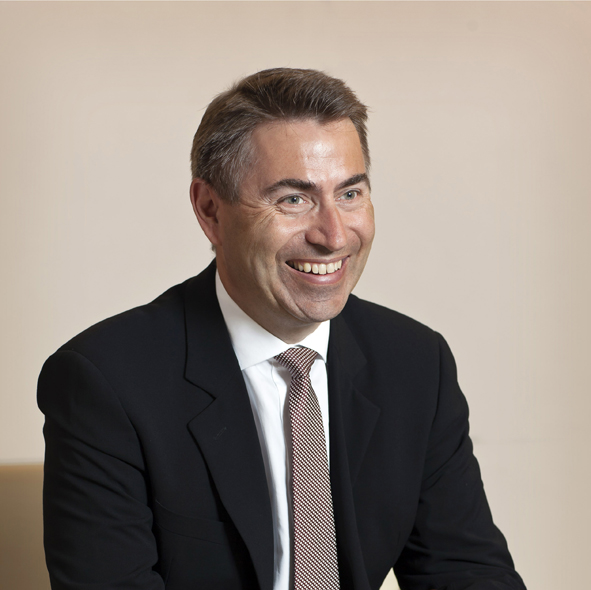‘Custody is dead. Long live custody’
(pictured: Laurence Bailey)
By Greg Bright
It’s been a popular saying of Laurence Bailey for many years. And, as the custody veteran prepares for the next phase of his life, most likely to involve teaching or coaching, it is as true today as it was when he started in the industry in the 1980s – remarkably, at the same organisation from which he now retires.
Bailey, 55, leaves JP Morgan in the second quarter, after a career which began in the UK with one of the big bank’s predecessors, Chase Manhattan Bank, in 1983. To a large extent, that career represents a microcosm of the evolution of the custody and securities servicing sector itself throughout the region and, especially, Australia.
Just as custody has survived through many technological, demographic, regulatory and economic disruptions, so has Bailey survived many restructures, mergers and sales for which all the banks are famous, or perhaps infamous. Sure, custody is dead, but don’t mourn too much. For, long live custody’s next iteration.
The 1980s were big for Australia in general and the finance and investment sector in particular. The Hawke Government, with Paul Keating as Treasurer, ended the Coalition rule of eight years in 1983 and set about a series of major reforms to banking and finance, foreign exchange management and pensions, internationalising investment management in the process.
Then there was the Accord, in 1986, which gave birth to Award Super, the start of many industry super funds and a dramatic change in the way Australians saw themselves in the world. We were at the forefront, for once, and have remained there, at least in the sophistication of our institutional investment platforms, through subsequent governments and economic booms and busts.
Sensing the growth in superannuation, two big US companies opened up shop in Australia in 1986 – Russell Investments and State Street. Russell introduced sector specialist management, giving rise to a plethora of new investment capabilities locally and from around the world, and State Street introduced master custody, giving rise to modern securities servicing which enables the increasing complexity of investments.
As an aside, 1986 was also the year when the investment industry got its first specialist trade publications. I launched Super Review as a monthly magazine, to compete with the bi-monthly ASFA-owned SuperFunds, and David Koch launched Money Management to cater for the new world of retail managed funds.
Bailey recalls that, released from the shackles of many regulations, big Australian institutions such as AMP, started to invest some serious money offshore. He was moved to Hong Kong in 1990 as foreign fund managers opened offices either for investment research or execution and Asia Pacific institutions, led by the central banks and insurance companies, started to invest overseas for the first time.
“AMP and other Australian institutions had really started to explore cross-border investing and we wanted to support them from Hong Kong,” he says.
About a year later he moved to Australia – initially to Melbourne and then settling in Sydney – where he remained until 2000 as head of JP Morgan’s securities servicing business for Australia and New Zealand. This was the golden decade for custody and securities servicing. At first it was a land grab, as all sorts of organisations rushed to provide master custody to the nascent super funds and mushrooming boutique fund managers.
In 1990, there were about 5,000 super funds in Australia, the vast majority being small corporate funds. Today, there are fewer than 100 APRA-regulated funds which still have active control of their investments and more than 500,000 SMSFs. You can imagine how the difference in the industry’s structure impacts the business models of the service providers, such as the remaining custodians.
While State Street had the first mover advantage in master custody, it did not have the market to itself for very long. By the time Bailey arrived from Hong Kong, in 1991, Chase/JP Morgan had launched its offering, as had National Australia Bank, Westpac, ANZ, AMP (which became Cogent and eventually BNP Paribas), Commonwealth Bank, Morgan Stanley Trust Bank, Bankers Trust, Perpetual Trustees (now RBC) and Permanent Trustee Company.
“It was a wild time,” Bailey says. “And David Taplin spiced it up even more and genuinely moved the market for custodians. He introduced complex SLAs (service level agreements) and fierce competition in fees.”
The late David Taplin launched a custody consulting arm for Towers Perrin, which had also started its own investment consulting division in 1986, and later migrated to Deloitte. Either by design, to further his own business, or as a natural consequence of his work, Taplin spread his recommendations among the several custodians in the market, taking a lot of the growing business away from State Street in the process.
Taplin, who died in 2007, also inspired competition for himself, with Mercer and Intech (now Ibbottson) starting specialist custody consulting units.
“They [custodians] all moved down to Australia because they saw that the market was rapidly expanding because of the SG and State Street was the only game in town. Fees were high and services required were simple, they thought. Well, three out of four of those were true,” Bailey says. “The required services were clearly not simple and not just because of the Australian tax system.”
Scale was very much an issue. “When I first met one of our boutique Aussie equities fund manager clients, I realized that they executed more derivative transactions in a year than the rest of our client base in Europe combined,” he says.
“Global systems did not work as effectively as they needed in Australia, cut-off times were aggressive and fund structures were being put into place for long-term visions, which made them extremely expensive to run.
“I like to recall that Australian Retirement Fund (ARF) was the first or one of the first funds we won when I arrived in Australia – $300 million AUM and at least 30 individual portfolios. Yes 30, so only $10 million per fund. ARF, which became Aussie Super after its merger with STA, is now getting on towards $100 billion in AUM, and has in-house management, but it doesn’t necessarily have a huge number of additional funds.”
But by the end of the 1990s and early 2000s, the wild ride was coming to an end. Non-banks, such as Perpetual, Permanent and AMP, and those which didn’t like the low-margin transactional nature of custody, such as BT and Morgan Stanley, decided to exit and were acquired by the major players. The Aussie banks, with the exception of NAB, followed.
Ever the competitor, Bailey points out that there were some odd and ill-thought-out deals done along the way. State Street, for instance, as market leader became the global custodian for Westpac, even though it competed for the more lucrative master custody business. Westpac exited but then State Street later sold its superannuation business, consisting of more than 20 funds, to Commonwealth, while retaining the global custody. A year later, however, Commonwealth then sold its master custody business to NAB, with State Street thereby losing the global custody mandate. A few years later, State Street re-entered the superannuation sector. It now boasts some big names, such as REST, Sunsuper and QSuper, but vacated the number-one spot in super to JP Morgan along the way.
With the Commonwealth super business, NAB gained the number one spot for total assets under custody, a position which it has retained but is increasingly under threat. For its part, JP Morgan acquired Morgan Stanley Trust’s small Australian business as part of a global deal, and that of BT in Australia and, more recently, ANZ.
The BT deal was a big one for Bailey but after that firm was acquired by Westpac most of the assets were transferred over to it’s outsource partners – now mainly HSBC. The significance of the BT deal, though, was what it meant for middle-office outsourcing, which, until then, was almost unheard of.
Bailey says: “This was certainly the time globally when middle office outsourcing was starting to gain traction. State Street did its PIMCO deal in the US, and we did our Schroder’s deal in the UK as well as the BT deal.
“The important thing about middle-office deals is to fully understand the motivation of a fund manager to outsource. Almost always it is a cost reduction play, either current run rate, or indeed future investment requirements. As we saw with BT, it was even more than that because the underlying fund manager changed hands from BT to Deutsche to Principal and then finally Westpac in the space of a few years.
“Middle-office outsourcing is seen as the stickiest business within the securities administration space, and whilst it is, the major question is whether the underlying client remains in charge and under the same ownership, which is not always the case. When their businesses get sold – often more than once – that sticky relationship comes unstuck very abruptly.”
For Bailey, the BT deal also gave him the new experience of spearheading a major M&A transaction between banks. He warmed to the task, with the confidence to look around for other such deals.
He next tried to buy the ANZ custody business, unsuccessfully, but eventually won the day some years later at a much-reduced price. He also had various discussions with NAB, to try to split its partnership with BNY Mellon as global provider. At one stage discussions are said to have involved JP Morgan giving up domestic custody to win the Aussie bank’s global. Nothing eventuated. Late last year NAB finally ended its BNY Mellon relationship of more than 20 years through the appointment of Citi as its new global custodian. The jockeying for position is never ending.
Like HSBC and, for many years, Citi, BNY Mellon – the world’s largest securities servicing firm – has stayed out of master custody in Australia, but it has been part of the landscape. For instance, the inaugural chair of the Australian Custodial Services Association in 1992 was Brian Slade, then head of global services in Australia for Bank of America, whose business was subsumed into BNY Mellon in the mid-1990s.
ACSA was an important milestone for the sector and remains the only organisation of its type in the world, representing the full array of custody and securities servicing companies with offices in Australia. Its most recent associate membership has gone to the Bank of China.
ACSA was actually set up by former NAB custody executive John Gall, who provided secretarial services and drove the membership and also much of the lobbying effort. NAB’s then head of custody, Mike Pratt, became the second ACSA chair and Laurence Bailey its third, in 1995. Bailey was keen for ACSA to have a voice which was heard both within the industry and with the regulators.
As another aside, Bailey decided a conference would be a good help to lift ACSA’s profile and approached me, then at Investor Weekly, to organize a custody conference in 1996. My first attempt failed to go ahead for lack of sponsorship but Bailey persisted. The next year he pledged JP Morgan as an underwriter for the event, to make sure it happened. It was a success and JP Morgan had no shortfall to pick up. The 19th annual conference, now produced by Conexus Financial, took place in Sydney last week.
For its part, ACSA has become an integral part of the industry’s interface with the regulators, particularly given all the changes since the GFC. After John Gall took a part-time job with a fund manager, ACSA passed its secretarial work onto the FSC, but maintains several key committees to oversee its role on behalf of members.
Bailey was promoted to head up securities servicing for the region – as CEO, Investor Services, Asia Pacific – and moved back to Hong Kong in 2000, from where he has overseen Australian sales and client servicing as well as spearheading JP Morgan’s broader Asia Pacific drive for the past 15 years, making the firm the largest global custodian in the region.
He says: “In 1990, when I went to Hong Kong for the first time, just a kid, really, from England, we had almost zero assets sourced from Asia Pacific. Today, we have US$2 trillion invested all over the world from Asia, in every type of instrument, many being valued daily, with hundreds of thousands of transactions executed daily, and with many others being lent through securities lending programs and most being reviewed and reported against varying performance benchmarks.
“The region has come a long way in 25 years and it will surely continue to grow as quickly over the next 25 years, with Australia leading the way, thanks to superannuation.”
While consolidation in Australian custody and among the big super fund clients has been a constant theme of the past 15 years, it has not meant that there are no new faces. Northern Trust has shaken up the market by not only winning NZ Super and the Future Fund as clients but, more importantly, developing an Australian tax engine to do master custody for super funds and winning a significant share of that market. Making the market a little more interesting, too, in 2013 was the decision by Citi to expand in master custody, winning its first industry fund client (Host Plus). Only HSBC, the largest custodian of Australian sub-custody, has kept to its core custody business. RBC, which acquired Perpetual’s business and retained Perpetual Investments as its biggest client, has also stayed on its chosen path providing securities servicing only to fund managers and not to super funds.
Bailey points out that another consistent theme has been the predictions of many pundits that with ‘dematerialisation’ and central depositories, custody will be completely commoditised and new entrants will come in from outside of banking, such as Google.
“It’s a fact that basic safekeeping and asset servicing is becoming more complex and diverse,” he says. “And, yes, clients take it for granted and focus on valuations/tax reporting/unit registry and speed of data transfer – all of which are vital and need to get better.
“However, the assets that are being invested in are so diverse, both from country of investment and types of investments… And the servicing of these assets is becoming more complex, such as with more complex corporate actions and tax treatment of various options.
“Therefore, basic asset servicing and settlement remains at the heart of any provider’s capabilities. Custody lives and breathes and gets harder and more complex with millions of dollars invested by the industry annually, above and beyond all the ‘added-value’ services.”
On Australia, he says that it remains a market where custodians are asked, or forced, to provide services that funds and managers don’t want to do themselves, such as outsourcing, tax reporting and retail registry.
“Sophistication remains high and far ahead of most of the world in terms of choice of funds, investment choice, in-house management of assets, and the use of alternatives and derivatives,” he says.
“The balance between global and local systems seems to dominate discussions from clients versus the actual capabilities of each provider. Also, added-value services, such as lending/FX /trading are starting to gain traction. New regulations are also changing some of the fundamental business drivers for the different banks.”
Bailey believes there are four categories of custodian relevant to the Australian market: local banks (NAB only); European banks (BNP Paribas); global banks (JP Morgan and Citi); and ‘monolines’ (State Street and Northern Trust).
“Each has its pluses and minuses with regards to appetite for various roles and capabilities around the functions of holding cash and provision of market products,” he says. “They are also different in terms of the size of their business and their importance within the overall parent bank.”
Bailey has been replaced in his role as regional head of Investor Services by Shaun Parkes, who most recently was the Asia ex-Japan head of client management, handling the largest and most complex clients of the firm. Parkes previously reported to Bailey.
For Bailey’s part, he says he is “far from retiring”, though. “The next phase of my life will be slightly less frantic as I’m looking to move into teaching [he has taught various MBA courses over the years] as well as executive coaching. I want to share some of my experiences from across the region over many years.”
One of those experiences was both a highlight and lowlight of his career – a massive challenge in crisis management which still gets spoken about 16 years after the event.
It was Christmas 2003 and a group of experienced criminals attempted to steal $150 million from the account of one of JP Morgan’s largest clients, the Commonwealth Superannuation Corporation (then known as ARIA).
“It was a very elaborate scheme,” Bailey says, “which led to me having to call my US boss and try to explain that while the attempt was made, everything was under control and we were talking to all parties! The highlight of this was that we were able to retrieve the vast amount of the funds and I learnt more about international crime prevention than I ever thought possible, plus I got to appear on national TV!” The criminals were caught and the masterminds are still doing time.
About the same time, NAB was hit by an FX scandal which, while not exactly related to custody, caused many large institutions to look more closely at their security systems. In some respects, these two headline crimes were precursors to the cyber attacks, which have been in the news over the past couple of years.
Bailey believes that it is important for everyone to have a sense of history. You don’t know who you are unless you know where you have come from. That’s as true in business as it is in life generally. It is important for every industry – such as custody and securities servicing, as dull as they may sound to the rest of the funds management industry – to know where it came from and how it got to be today.
“It’s also important to regenerate and to foster new people as well as ideas,” he says. “That’s what I’ll be doing in the next phase of my life.”










